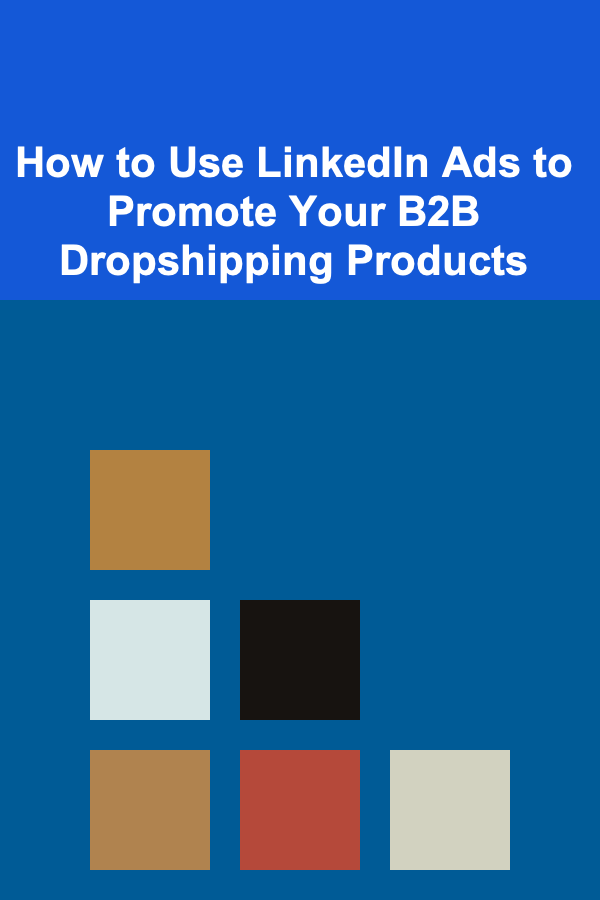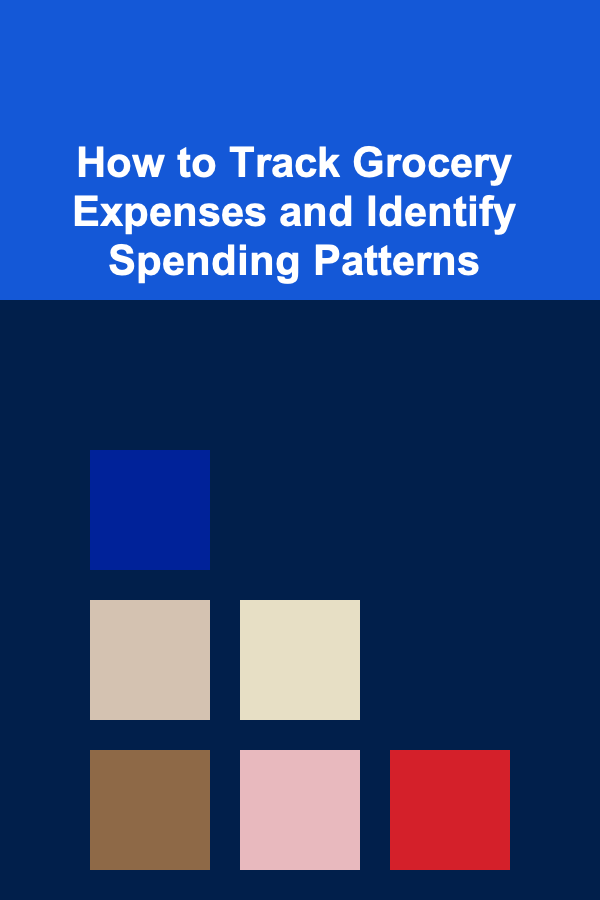
How to Use LinkedIn Ads to Promote Your B2B Dropshipping Products
ebook include PDF & Audio bundle (Micro Guide)
$12.99$5.99
Limited Time Offer! Order within the next:

In today's digital landscape, advertising on LinkedIn has emerged as a potent strategy for promoting B2B products. LinkedIn's unique professional network allows businesses to reach decision-makers, business owners, and professionals in ways that other platforms cannot. For dropshipping businesses in the B2B (business-to-business) niche, LinkedIn ads present a prime opportunity to expand reach, engage potential clients, and drive conversions.
In this guide, we'll explore how to effectively use LinkedIn Ads to promote your B2B dropshipping products, optimize ad campaigns, and convert leads into sales. By following these actionable steps, you can ensure that your LinkedIn advertising strategy is both efficient and effective.
Why LinkedIn Ads for B2B Dropshipping?
LinkedIn is primarily a professional networking platform, making it the perfect environment for B2B businesses to connect with their target audience. According to LinkedIn, over 60% of its users are in senior positions, which means your ads can reach key decision-makers such as CEOs, managers, and procurement officers. This is especially important for dropshipping businesses that deal with bulk orders, wholesalers, or corporate clients.
Additionally, LinkedIn Ads offer several targeting features that can help refine your audience based on their job title, industry, company size, location, and more. These features make LinkedIn one of the most effective platforms for B2B advertising, particularly for dropshipping businesses that need to find the right audience quickly.
Step 1: Define Your Objective
Before launching any ad campaign, it's crucial to set a clear objective. LinkedIn offers a variety of campaign objectives, each designed to achieve specific goals. Here are some common objectives that would suit a B2B dropshipping business:
- Lead Generation: This is one of the most effective goals for dropshipping businesses. You want to capture contact details (email, phone number, company name) of potential clients who may be interested in bulk buying.
- Website Traffic: If you want to drive traffic to your product landing page or e-commerce store, you can set your campaign to optimize for website visits.
- Brand Awareness: If your goal is to introduce your dropshipping business to a wider B2B audience, this is the objective to choose. LinkedIn will focus on delivering your ads to as many professionals as possible to increase awareness.
- Engagement: This goal helps to generate interactions with your ads, whether it's comments, likes, or shares. It's useful for building relationships and trust, particularly if you're introducing your products to new audiences.
Choosing the right objective aligns your campaign with measurable results and ensures you're targeting the right actions for your business goals.
Step 2: Define Your Target Audience
The most significant advantage of LinkedIn Ads is its targeting capabilities. LinkedIn allows you to filter your audience with precision, and this is key to a successful B2B dropshipping campaign. Here's how to define your audience effectively:
- Industry: Use LinkedIn's industry filter to focus on businesses in relevant sectors that would be interested in your dropshipping products. For instance, if you sell office supplies, target industries like "Retail," "Manufacturing," or "Consulting."
- Company Size: Target businesses based on their size. You may want to focus on small to medium-sized businesses (SMBs) that need reliable suppliers for bulk purchasing, or larger enterprises that require consistent product replenishment.
- Job Titles: In the B2B world, decision-makers such as procurement officers, supply chain managers, and even CEOs are the ones who will be making purchasing decisions. You can narrow down your target by job titles, ensuring your ads reach the right people.
- Location: While LinkedIn allows for global advertising, consider narrowing your geographic targeting to focus on regions where your products have a strong demand or where you can provide the best service.
- Company Growth and Seniority: If your dropshipping products are intended for fast-growing businesses or established companies, you can also use LinkedIn's filters to target professionals based on their company's growth rate or seniority level.
The more precise your targeting, the more relevant your ads will be, increasing the likelihood of driving high-quality leads.
Step 3: Choose the Right Ad Format
LinkedIn offers various ad formats, and choosing the right one is essential for maximizing engagement and driving conversions. Below are the ad formats that are most suitable for B2B dropshipping:
1. Sponsored Content
Sponsored Content is native advertising that appears directly in users' LinkedIn feeds. These ads look like regular posts but are labeled as "sponsored." They can include text, images, videos, and even carousels. This format is effective for promoting individual products or showcasing multiple products in a visually appealing way.
- Best for: Highlighting specific products or services, demonstrating their use cases, or promoting special offers.
- Tip: Use high-quality visuals and clear calls-to-action (CTAs). If you're showcasing multiple products, consider using a carousel ad format, which allows users to swipe through images or videos.
2. Text Ads
Text Ads appear on the sidebar of LinkedIn and consist of a short headline, description, and a small image. Although not as visually striking as Sponsored Content, text ads can be highly effective due to their simplicity and low cost.
- Best for: Generating leads, directing users to a landing page, or encouraging them to sign up for newsletters.
- Tip: Since space is limited, make sure your headline is compelling and concise. Use strong verbs and focus on the benefits of your products.
3. Sponsored InMail
Sponsored InMail allows you to send direct messages to users' LinkedIn inboxes. This can be a powerful way to establish a personal connection with potential clients.
- Best for: Direct outreach to decision-makers, offering personalized deals, or scheduling a call to discuss partnership opportunities.
- Tip: Personalize your messages and make sure you include a clear CTA. Avoid overly salesy language and aim to build a relationship rather than just pushing for a sale.
4. Dynamic Ads
Dynamic Ads are tailored to individual users based on their LinkedIn profile information. For example, you can create an ad that uses a user's profile image to increase engagement.
- Best for: Increasing brand awareness and engagement, especially when you want to catch users' attention with personalized content.
- Tip: Use this format to showcase your brand or business, such as a call-to-action for potential clients to learn more about your dropshipping products.
5. Video Ads
Video Ads allow you to showcase your products in action. They are ideal for demonstrating the features and benefits of your dropshipping products in a way that static images can't match.
- Best for: Product demonstrations, customer testimonials, or educational content about your products.
- Tip: Keep the video short (under 30 seconds) and focus on a single message. Make sure the first few seconds capture attention and keep the content relevant.
Step 4: Craft Engaging Ad Copy
Great ad copy is key to driving conversions on LinkedIn. Here are some tips for writing compelling B2B dropshipping ad copy:
- Be clear and concise: Professional LinkedIn users are busy, so get straight to the point. Avoid jargon, and make sure the benefits of your product are immediately clear.
- Use a strong call-to-action: Whether you want users to visit your website, download a resource, or make a purchase, your ad should have a clear CTA that tells the user what to do next.
- Address pain points: Focus on how your dropshipping products can solve a problem for the potential client. For example, "Looking for a reliable supplier for your business? We offer fast shipping on bulk orders."
- Offer value: Give users a reason to engage with your ad. Offer a discount, a free consultation, or access to a limited-time offer.
Step 5: Optimize Your Landing Page
Once users click on your LinkedIn ad, they should be directed to a landing page that is directly related to the offer in the ad. This page must be optimized for conversions. Here's how to ensure it's effective:
- Match the message: The copy, images, and offer on the landing page should directly reflect what was promised in the ad.
- Fast loading time: A slow-loading page will lose potential leads. Ensure your landing page loads quickly to avoid high bounce rates.
- Clear CTA: Just like your ad, the landing page should include a clear CTA, whether that's signing up for a newsletter, requesting a quote, or making a purchase.
Step 6: Track, Analyze, and Adjust
Once your campaign is live, continuously track its performance using LinkedIn's Campaign Manager. Key metrics to monitor include:
- Click-through rate (CTR): This shows how engaging your ad is. If the CTR is low, try adjusting your targeting or tweaking the ad copy.
- Conversion rate: Measure how well your landing page is converting visitors into leads or customers. If the conversion rate is low, you may need to revise your landing page or offer.
- Cost per lead (CPL): This metric helps you understand how cost-effective your campaign is. If CPL is too high, experiment with different targeting options or ad formats.
Adjust your strategy based on these insights, and continually optimize your ads for better performance.
Conclusion
LinkedIn Ads are a powerful tool for promoting your B2B dropshipping products. By defining your goals, understanding your target audience, choosing the right ad format, crafting engaging ad copy, and optimizing your landing page, you can create a highly effective LinkedIn ad campaign. Regular analysis and optimization will help you refine your strategy and ensure you're reaching the right decision-makers at the right time. With the right approach, LinkedIn Ads can be a game-changer for your B2B dropshipping business.
Reading More From Our Other Websites
- [Personal Care Tips 101] How to Use Body Lotion to Combat Dry Skin in Winter
- [Personal Care Tips 101] How to Choose a Cruelty-Free Hair Gel for Ethical Beauty
- [Personal Care Tips 101] How to Apply Brow Gel for a Bold and Dramatic Brow
- [Personal Investment 101] The Best Ways to Generate Passive Income with Deep Learning
- [Home Storage Solution 101] How to Use Vertical Storage to Save Floor Space
- [Organization Tip 101] How to Use a Dry Erase Board for Daily To-Do Lists
- [Personal Finance Management 101] How to Negotiate Bills and Save Money on Monthly Expenses
- [Ziplining Tip 101] Behind the Harness: How Modern Gear Keeps Zipline Riders Secure
- [Home Soundproofing 101] How to Use Soundproof Foam Panels to Improve Your Home's Acoustic Quality
- [Home Party Planning 101] How to Plan a Decade-Themed Retro Party (e.g., 80s, 90s) in 2023

How to Clean and Maintain Hardwood Floors for Long-Lasting Shine
Read More
How to Master Basic Sushi Rolling
Read More
How To Train Your Dog to Leave It
Read More
How To Master Acoustic Guitar Fingerpicking
Read More
How To Debunk the Big Pharma Conspiracy
Read More
How to Track Grocery Expenses and Identify Spending Patterns
Read MoreOther Products

How to Clean and Maintain Hardwood Floors for Long-Lasting Shine
Read More
How to Master Basic Sushi Rolling
Read More
How To Train Your Dog to Leave It
Read More
How To Master Acoustic Guitar Fingerpicking
Read More
How To Debunk the Big Pharma Conspiracy
Read More